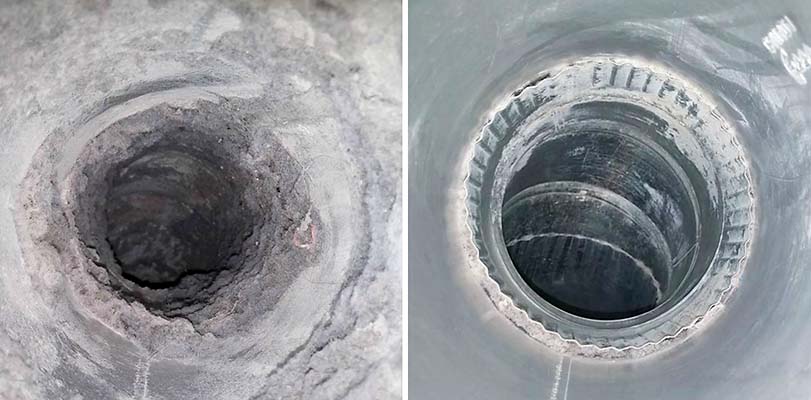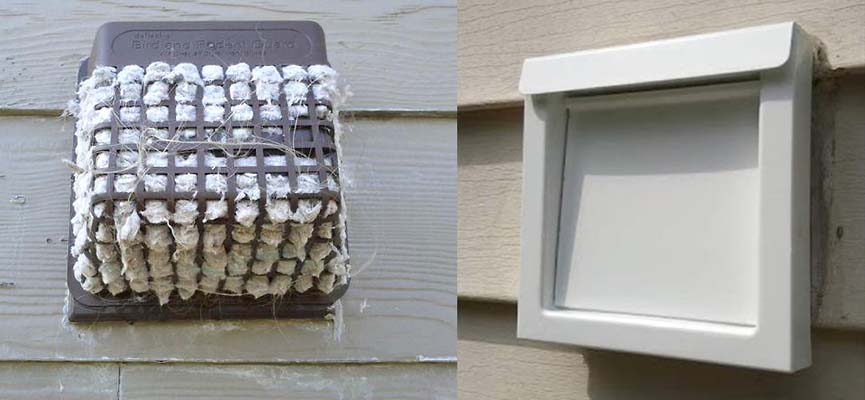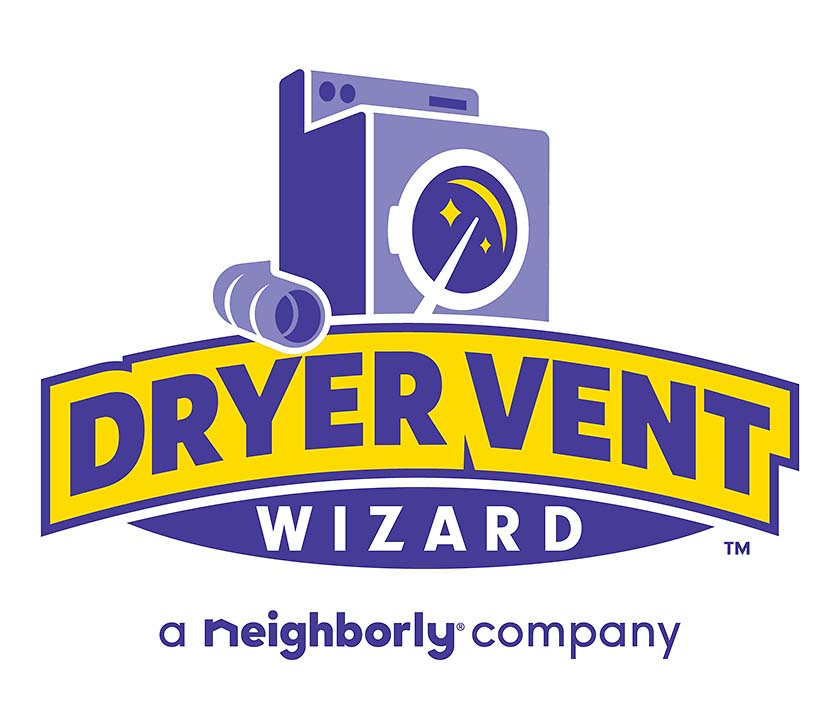Why “Dryer Vent Cleaning” Isn’t Enough

Customers usually call us asking to have their dryer vent cleaned with the expectation that this is a simple, quick task. Cleaning is an important part of dryer vent servicing — however — our work involves much more than that. Why? Because the safety and efficiency of your dryer vent is our goal, and a simple cleaning may be ineffective, and may not even be possible, without addressing other important issues.
Dryer vent systems are often an afterthought in home construction. Many were installed years ago using components and materials that today are not permitted by building codes and are warned against by dryer manufacturers. Many installers take shortcuts or aren’t aware of code requirements that limit risk, are efficient, and allow your system to stand the test of time. Time takes its toll on dryer vent systems which can fall into disrepair, causing issues including risk of fire, clothes that won’t dry in two or more loads, water damage, damage to your fabrics, risk of carbon monoxide poisoning from gas dryers, and mold and mildew buildup affecting the air you breathe.
When a dryer vent service comes to your home, it’s is important that they perform complete inspection of your system to answer basic questions including:
What is your dryer vent line made of? All dryer vent lines should be made of 4” rigid metal or aluminum. If you have plastic flexible duct or even “semi-rigid” aluminum, it should be replaced. Why? First, it can’t be cleaned with rotating brushes which can tear apart the vent line, often behind walls. Plastic or metal foil flexible duct (“slinky foil”) is flammable, its “accordion” structure collects lint, crushes easily, and the material can deteriorate over time. Semi-rigid aluminum is prone to kinks, perforations and crushing, which leads to blockages, poor airflow and released lint.

How long is your vent line? How many turns and bends does it have? Is it mainly vertical or horizontal? Line length is critical in understanding how well your dryer vent will perform. It takes a lot of air pressure to deliver over a gallon of water moisture, lint, and heat to the exterior of your home with every load. Bends in the line add to its effective length, and a vertical line makes venting harder due to gravity. Lines effectively 35 ft. or longer require a booster fan to move the hot air and lint along. Sometimes, rerouting the vent line to shorten it is a good option, if possible.
How blocked is your vent line? Airflow tests should be conducted before and after cleaning to measure the level of blockage, and to see the improvement after work is completed.

Do you have gas or an electric dryer? Gas dryers pose the additional risk of carbon monoxide backing up into your home from a blockage. While gas dryers generally heat up more quickly and run hotter, drying your clothes faster, this risk makes it especially important that your dryer vent is clean, made of the correct components and is properly sealed and tested.
What is the state of your flexible “transition?” This is the flexible hose behind your dryer that connects it to your main vent line. Metal “slinky” foil ducts, commonly used, generally provide heat resistance but are not fire and flame proof. Remember, if a fire starts in a dryer it will spread through this transition into the vent line, so you want it to be non-flammable! Semi-rigid aluminum is often used and is non-flammable, but is prone to crushing, kinking and perforations, especially if you try to push your dryer back. There are better options, such as non-flammable flexible ducts made of wound aluminum ribbon that resist crushing and regain their shape if compressed. Transitions should be as short as possible. The transition is often a bottleneck, and may need to be shortened, replaced, or repaired to ensure strong airflow.

Is the inside of your dryer clean? Much lint passes through your lint screen into the dryer itself. The channel under your lint screen that leads to the exterior of the unit accumulates lint over time. Lint can also build up in the main compartment where the heating element or gas flame resides. These (and even static electricity) can spark a fire inside your dryer that spreads to the vent line. Your dryer should be inspected and cleaned out as necessary.
Is your vent cover working properly and does it suit your needs? Plastic vent covers can warp and deteriorate due to weather, the sun and time. The louver flaps may no longer open or become brittle and break, causing a bottleneck at the end of the line. Additionally, birds and pests enter through vent covers and make nests in the line, a common cause of dryer vent blockages. Many homes have grills or screens over their vent covers to prevent this, but they should be removed. Grills gather lint and create a blockage right where the lint, moisture and air need to escape! Newer vent covers prevent pests from entering the vent line without a grill, and some are made of steel which will last the life of your home. If pests are an issue, have a pest resistant vent cover installed, and take off that grill!

What is the overall state of repair? Even if made of proper materials, dryer vent lines often need repairs, such as ensuring that connections are tight, and the vent pipe is sealed with highly rated foil tape. Buildup of lint anywhere outside the dryer indicates loose connections, which should be corrected.
Dryer vent lines are their own animal. Unlike HVAC ducts or bathroom vents, over a gallon of water, plus lint and heat pass through them with every load. Lines clogged with lint, which acts as a sponge, can become heavy with water and leak behind your walls. When it dries, the lint cakes up forming a hard barrier that blocks air and is highly flammable. Workers lacking knowledge of dryer vents may overlook major issues and often don’t have the proper tools, components, and materials to correct serious problems.
A dedicated dryer vent service business will inspect your entire system, and make recommendations to ensure it is code compliant, safe, and efficient. This is why dryer vent cleaning alone is not enough to protect your home and family. Much of our work involves repairs, installations, reroutes, component upgrades and more. Cleaning is important but is only effective if the entire dryer vent system is properly constructed and in good repair.
The benefits are great. A properly functioning dryer vent line reduces the risk of dryer fires, carbon monoxide poisoning (with gas dryers), and mold/mildew buildup from backed up moisture that can’t escape. It also improves the efficiency of your dryer. After all, if you must run a load twice to dry your clothes, that is a waste of expensive energy, and the extended drying time can damage your fabrics and reduce the life of your dryer.
Dryer Vent Wizard is a full-service business focused only on dryer vents. Our trained and certified technicians follow an inspection process, discuss their findings with you and answer your questions. They are outfitted with the right tools, materials, and components to take care of almost any job in one visit.
Dryer Vent Wizard is fully insured, and offers a 90-day guarantee on our work, our “Done Right Promise.”
To schedule an appointment with Dryer Vent Wizard of Norwalk:
- Schedule online or visit our website at: www.norwalkdryervent.com
- Schedule by phone: (203) 803-2068
- E-Mail: jselden@dryerventwizard.com
- Facebook: DryerVentWizardofNorwalk
We operate in: Norwalk, Fairfield, Westport, Darien, New Canaan, Wilton, Weston, Easton, Ridgefield, and Redding.
Discounts: 10% off for seniors and veterans.
Connecticut Home Improvement Contractor: HIC.0662346

